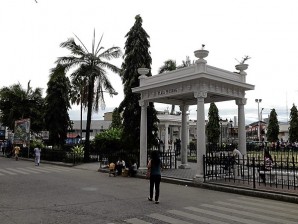Zamboanga park comes back to life
ZAMBOANGA CITY—Thirty-eight-year-old Rachel Manuel of Barangay Putik here was busy packing a snack box. The food was for her, her four children and her husband, she said.
Their destination: Plaza Pershing, named after an American general who fought in the Filipino-American war, and sits in the downtown area near city hall.
“When we were young, we did not come here because we were afraid,” Manuel said.
Until about three months ago, Plaza Pershing was the hub of the city’s underworld. It was where drug dealers, gun smugglers and robbers operated, according to Chief Supt. Mario Yanga, acting city police chief.
“Plaza Pershing became the center of illegal trade in the past. All you needed to do was to approach the right person if you wanted ammunition, guns or even women,” Yanga said.
Article continues after this advertisementThese are the main reasons locals kept away from the park.
Article continues after this advertisementCarmencita Ramirez, 45, who recently returned home from a job in The Netherlands, said it was her first time to set foot at Plaza Pershing since she was born.
Ramirez said Plaza Pershing was notorious for being “the hub of prostituted women.”
“I did not want to be mistaken for a prostitute,” she said.
But since the city government renovated the park and put up attractions, like a fountain, the people of Zamboanga have learned to fall in love with Plaza Pershing again. “It became more of a family-oriented park now,” Ramirez said.
Manuel said Plaza Pershing has become the favorite hangout of poor families nowadays.
“There is this tall fountain to enjoy. After a long walk from the shrine, we come here to rest and enjoy the sights,” she said.
Indeed, Plaza Pershing has become the poor man’s weekend stopover, Medardo Sotto, a maintenance employee of City Hall, said.
Sotto said the many people who come to the park made maintenance workers like him busy during weekends, sometimes staying late to clean up after visitors had left.
Sotto is aided by two other workers—sweepers Esperanza Corpus and Socorro Santos. He said the task of keeping the park clean was lighter before the renovation.
“Before, Plaza Pershing would look like a garbage dump in the morning and the so-called ‘rugby children’ were everywhere. That ugly sight is long gone,” Sotto said.
“If you are tired either from the market or from the malls, just take a break here, and just a few meters away you can already take a ride home,” Ramirez said.
Ludovico Badoy, executive director of the National Historical Commission of the Philippines, said Plaza Pershing’s rehabilitation enhanced historical landmarks in the city. He said the landmarks help remind Zamboangueños of their past under the Americans and the Spaniards.
Plaza Pershing was known during the Spanish time as Paseo de Don Juan de Salcedo. The park was the venue of public meetings and gatherings by Spanish generals.
It was later renamed in honor of Gen. John “Black Jack” Pershing.
The city government said it earmarked P7 million for the park’s facelift and the construction of amenities like a gazebo, a stage, restrooms, walkways, fences, lights, gardens and a drainage system.
Today, aside from families, Plaza Pershing also draws students from the nearby Universidad de Zamboanga, who come to the park for group studies.
“We are safe here,” Rahim Abdel, a 19-year-old college student, said. Just a few years ago, that was unthinkable.
